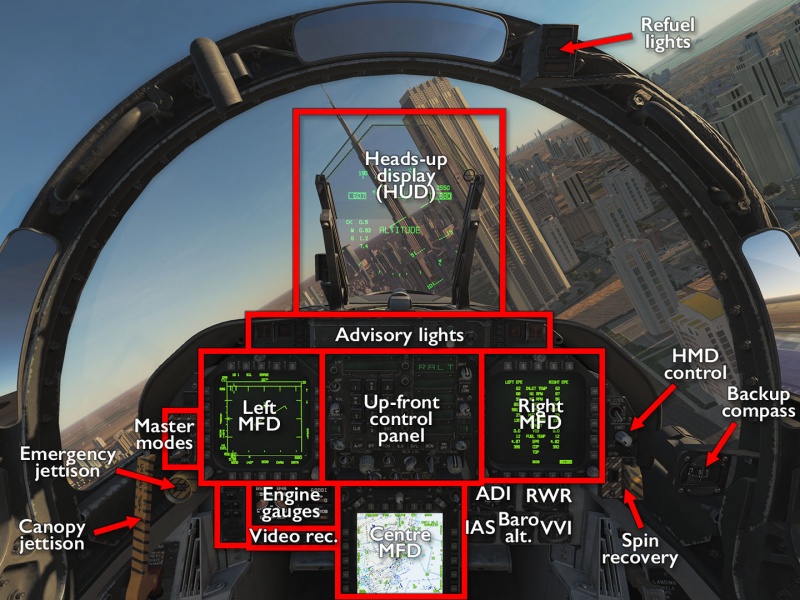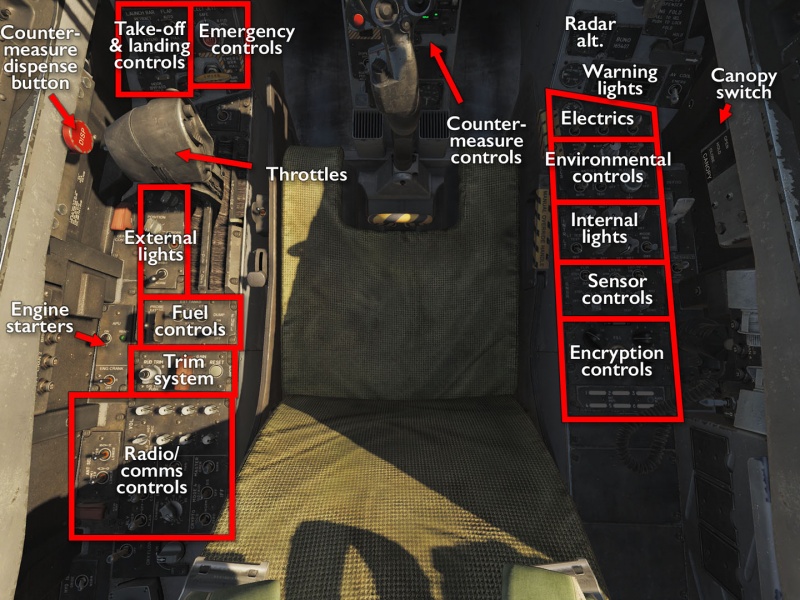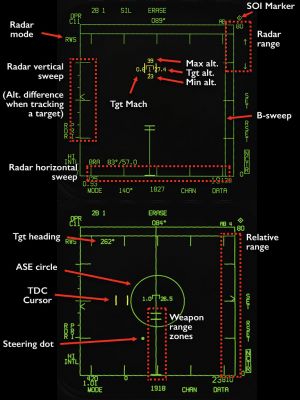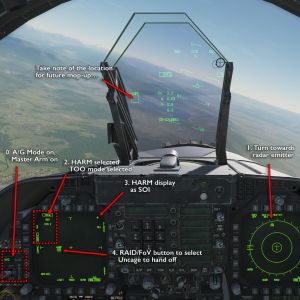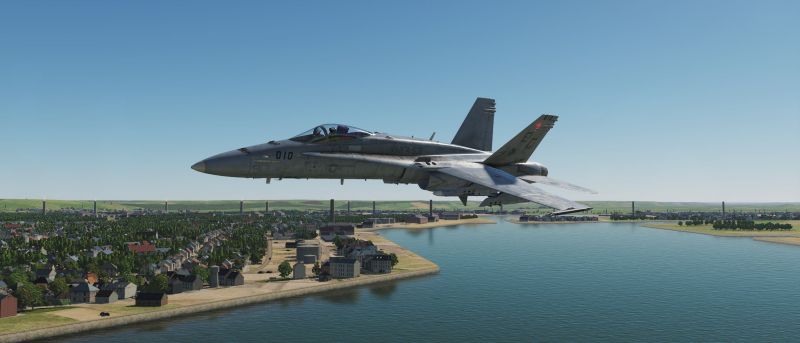FA-18C Hornet: Difference between revisions
m (→�) |
m (→�) |
||
| Line 44: | Line 44: | ||
=== Getting into the air === | === Getting into the air === | ||
In keeping with the goal of making the F/A-18C module parallel the A-10C in terms of being a full-on study sim, at least as far as on-board systems go, getting the Hornet up and running is an involved process. As always the {{Key|RWin}}{{Key|Home}} “cheat” key combo is available to automate the start-up process, but it takes a while and the auto-start (and even the mission-editor hot start option) still leaves some systems for the pilot to start manually — most notably the RWR and countermeasure system. | |||
It is not ''quite'' as long a process as in the A-10C, mainly thanks to the fact that there are fewer systems to set up and that the INS can leech off of the carrier to get its initial position data. At the same time, that slightly simpler system setup is counter-balance by the extra steps and the care needed to operate from a carrier. You do not want to have the engine roar to life while brake pressure is too low to keep the plane stationary, and you probably do not want to forget such tiny details as folding down the wings and hooking up to the catapult correctly. Taking an ignominious low-speed dive off the ramp, falling 15 meters into the water, exploding and then getting minced by propellers is not a good way to start the day. | |||
The manual and [[#Links_and_files|Chuck's guide linked below]] give a full account of the procedure, but the broad strokes are: | |||
* Making sure every type of brakes are '''on''' — chocks, parking brake, regular brakes, everything! | |||
* Turning power on, warning your surroundings, and checking for errors.<br><small>(Battery, APU, lights, brake test, APU check.)</small> | |||
* Turning engines on, starting with the ''right'' one.<br><small>(Right engine crank, right throttle to idle, monitor the spool up.)</small> | |||
* Turning on most of the avoinics.<br><small>(GPWS, MFDs, HUD, radar altimeter, bleed air, FCS.)</small> | |||
* Star aligning the INS — this will take a while. | |||
* Turning the ''left'' engine on. | |||
* Turning the remaining systems on and setting them up.<br><small>(Oxygen, hook, flaps, anti-skid, radar, trim, wings, ADI, RWR, etc etc etc.)</small> | |||
* Carefully start removing the brakes so you can get into position. | |||
* Line up, extend the launch bar, hook up (default bind {{Key|U}}), and run up the engines. | |||
* Kick in the afterburners (this may require manipulation of the finger lift levers depending on your settings) and ''keep your hands off the stick'' as the catapult and (hopefully accurate) trim setting gets you in the air and climbing. | |||
=== Shooting something === | === Shooting something === | ||
Revision as of 12:09, 6 May 2019
| This is a beta module.
This module is still being developed and may still be missing some features and equipment options. It is playable and most of the content is there, but some final touches and fixes for minor bugs are still in the works. It is probably safe to buy unless you crave absolute fidelity and/or very few bugs. |
The F/A-18C is slated to be one of, if not the most in-depth and complex module in the DCS stable, alongside the A-10C. It is still a work in (some would argue very slow) progress, which is perhaps understandable since the Hornet is a multi-role aircraft with the added complication that it is also carrier-based. It may not carry as many individually different weapons as the A-10C, but it already covers a much wider range of weapon types, and more are yet to come.
Overall, the Hornet is easy to fly and intuitive to use, and many systems will be familiar to, or even exact copies of, what you would find in the A-10C, AV-8B or even (in a much simplified form) in the F-15C. As such, it is not difficult to learn — there is just a lot to learn. If you have mastered the F-16C in BMS, getting to grips with it will be a cakewalk.
Features
Since it is a multirole aircraft, the feature list of the F/A-18C can easily become very long. The highlights include:
- All the hair-ripping, teeth-gnashing, fun and excitement of both carrier take-offs and landings, and air refuelling.
- More MFDs and glass cockpit features than is strictly necessary.
- Less than necessary engine thrust to compensate for all the MFDs.
- Tons of air-to-air missiles, including off-boresight, helmet-cued AIM-9X as well as AMRAAMS to always be able to shoot when the enemy cannot.
- AGM-88 HARM missiles for SAM hunting.
- Laser-guided bombs and Mavericks, as well as the regular set of unguided bombs and IR Mavericks.
- An extensive moving-map navigation suite that lets you fly via GPS, TACAN, NDBs, and a carrier-specific ILS system (that does not help you with regular airports).
- Programmable automated and manual RWR and countermeasure management, troubled by a constant debate on whether it should use an old inverted display (more dangerous targets farther out the threat ring) or not.
Comes with the built-in campaigns Hornet 1989 - Task Force Challenger.
Missing features
The F/A-18C is a work in progress, and while all the key systems to fly and fight in the thing are in already, the list of things that remain to be implemented is still fairly long.
- A proper TWS radar mode to get the most out of all those AMRAAMS.
- Similarly, the more advanced targeting modes for the HARM.
- More intertially guided munitions like JSOWs, and more programming options for them and for JDAMs.
- A targeting pod to actually guide your own GBUs and laser Mavericks and to provide more accurate targeting data for the aforementioned inertially-guided bombs.
- Some built-in sensors like ATFLIR that would let you sneak up on targets, MiG-29-style, and also somewhat alleviate the need for that targeting pod.
- Numerous flight model tweaks to make it less draggy and prone to fall out of the sky.
The last point is one of particular contention since the developers have acknowledged that the aircraft is more sluggish at low speeds (notably while doing carrier landings) than it should be, but have also insinuated that this is not something they particularly care to change.
Flying the F/A-18C
Flying the Hornet is an interesting experience. On the one hand, it is a modern agile fly-by-wire aircraft that will keep up with or out-manoeuvre anything else in the sky, but on the other hand, it is actually comparatively slow and sluggish. It is not like the A-10C or Su-25, where hills are life-threatening obstacles, and altitude is something you can only dream of, but it is also not a speed demon that stands a chance to keep up with the likes of the M2000C or F-14.
The airframe traces its historical roots to the F-5, and this shows. It's a joy to fly, but you need to be aware of the slow throttle response and that the top speed is enough to get you there, but it will not exactly break any records.
Cockpit overview
Getting into the air
In keeping with the goal of making the F/A-18C module parallel the A-10C in terms of being a full-on study sim, at least as far as on-board systems go, getting the Hornet up and running is an involved process. As always the RWinHome “cheat” key combo is available to automate the start-up process, but it takes a while and the auto-start (and even the mission-editor hot start option) still leaves some systems for the pilot to start manually — most notably the RWR and countermeasure system.
It is not quite as long a process as in the A-10C, mainly thanks to the fact that there are fewer systems to set up and that the INS can leech off of the carrier to get its initial position data. At the same time, that slightly simpler system setup is counter-balance by the extra steps and the care needed to operate from a carrier. You do not want to have the engine roar to life while brake pressure is too low to keep the plane stationary, and you probably do not want to forget such tiny details as folding down the wings and hooking up to the catapult correctly. Taking an ignominious low-speed dive off the ramp, falling 15 meters into the water, exploding and then getting minced by propellers is not a good way to start the day.
The manual and Chuck's guide linked below give a full account of the procedure, but the broad strokes are:
- Making sure every type of brakes are on — chocks, parking brake, regular brakes, everything!
- Turning power on, warning your surroundings, and checking for errors.
(Battery, APU, lights, brake test, APU check.) - Turning engines on, starting with the right one.
(Right engine crank, right throttle to idle, monitor the spool up.) - Turning on most of the avoinics.
(GPWS, MFDs, HUD, radar altimeter, bleed air, FCS.) - Star aligning the INS — this will take a while.
- Turning the left engine on.
- Turning the remaining systems on and setting them up.
(Oxygen, hook, flaps, anti-skid, radar, trim, wings, ADI, RWR, etc etc etc.) - Carefully start removing the brakes so you can get into position.
- Line up, extend the launch bar, hook up (default bind U), and run up the engines.
- Kick in the afterburners (this may require manipulation of the finger lift levers depending on your settings) and keep your hands off the stick as the catapult and (hopefully accurate) trim setting gets you in the air and climbing.
Shooting something
BVR engagement
Using the HARM
Links and files
- Chuck's F/A-18C Hornet guide at Mudspike.
- DCS: F/A-18C Hornet in the DCS shop.
More information
- McDonnell Douglas F/A-18 Hornet on wikpedia.
- F/A-18 Hornet on globalsecurity.org
- Matt Wagner's Hornet Training Videos series.



